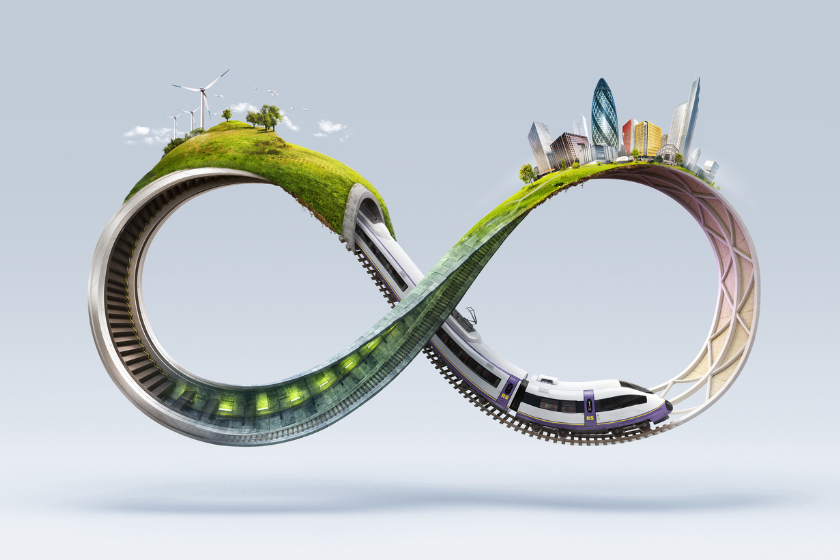ATO governance needs reform: IPA-Deakin SME Research Centre
The IPA-Deakin SME Research Centre has examined the shortcomings of the ATO’s governance model and proposed a Tax...
READ MORE
In a circular economy, value, impact and risk are redefined. From repurposing what was formerly regarded as “waste” material, to eliminating pollution, this non-linear economy can help save the world – and so can accountants.

At a glance:
“Accountants are ideally placed to help clients implement strategies that take advantage of opportunities in a circular economy and reduce the risk of business that does not consider its real impact on people and the planet,” says Dr Peter Ellington, Associate Professor in Accounting at the University of East Anglia, and CEO and founder of Triple Bottom Line Accounting.
Ellington wants to see more accountants commit to Sustainable Development Goals (SDGs) and Net Zero, and help their clients do so, before they are legally required to act.
“With larger companies already required to report on ESG, accountants should be incentivised to take account of both natural and social capitals for themselves and SMEs.”
The payoff, he says, is increased business and enhanced reputation as well as a better world.
Dr Mahmoud Gad, Assistant Professor of Accounting at Lancaster University Management School, agrees that accountants have a valuable role to play. He identifies transferable skills including a practical knowledge of business, measurement and management accounting, critical thinking, and target setting.
“Accountants also possess skills in regulatory compliance and the ability to analyse long-term financial implications of sustainability initiatives,” Gad says.
Unlike linear accounting, triple-bottom-line or holistic reporting has three ‘p’s not just one.
The first ‘p’ remains ‘profit’ or economic viability, joined by ‘people’ and ‘planet’.
Employee wellbeing, diversity and inclusion, a reduction in greenhouse gases, and long-term benefit for the Earth are all included in this way of accounting, which improves risk management and opens up new markets.
The challenge for accountants is not only how they ‘sell’ this change to clients but how they can establish metrics that have meaning for SMEs and, ultimately, will lead to further success.

In some instances, there may be short-term pain for long-term gain, says Ellington.
But pushing ESG and the circular economy aside just isn’t something accountants or SMEs can afford to do, he says.
As peoples’ perception of value shifts to goods’ or services’ longevity and recyclability as well as social and environmental impact, business-as-usual will go out the door, he believes.
The real risk for businesses, then, will not only be the detrimental effect they have on the planet, but their financial viability, says Ellington.
He suggests accountants offer guidance for SMEs on tax incentives or other credits and deductions related to sustainable, circular practices.
“Connect them with finance options like green bonds, or impact investment funds, to help fund their sustainability initiatives too,” he advises.
“Holding workshops or webinars for clients, where you talk about how their industry is changing and how they can take advantage of new opportunities, is also a good option.”
Ellington is a big believer in education not only for businesses, but for accountants. Gad also supports continuous professional development focused on emerging sustainability trends and challenges.
“Universities have started to integrate ESG and the circular economy into their curriculum to prepare the next generation of accountants.”
An explosion of ESG software offers tools for accountants who want to measure impact and enhance circular processes, Ellington says. He suggests the Sustainability Accounting Standards Board Material Map and GRI Guides for identifying material items for climate adaptation and risk management.
To assess carbon emissions, try tools like Normative, Sage Earth, or Ecologi Zero.
Accountants who are not confident with their skills in relation to triple-bottom-line reporting can consider partnerships with environment and energy experts, or outsource.

Lastly, accountants can help clients develop transparent, accurate and comprehensive reporting that meets shareholders’ new expectations and drives business change.
Gad says this would include a clear articulation of the company’s sustainability strategy and its alignment with business objectives, quantitative and qualitative disclosures on ESG metrics, employee welfare and diversity metrics, and disclosures on waste management and resource utilisation.
“Accountants need to incorporate natural capital accounting, which assigns a monetary value to ecosystem products and services, and analyse the life cycle assessment of products to determine their full environmental impact,” Gad says.
Of crucial value, he says, is helping clients assess the long-term cost savings and potential revenue streams from sustainable practices, assisting them in integrating sustainability into their core strategy and vision, and developing appropriate KPIs.
---
This article was first published by the IPA Group at Financial Accountant.